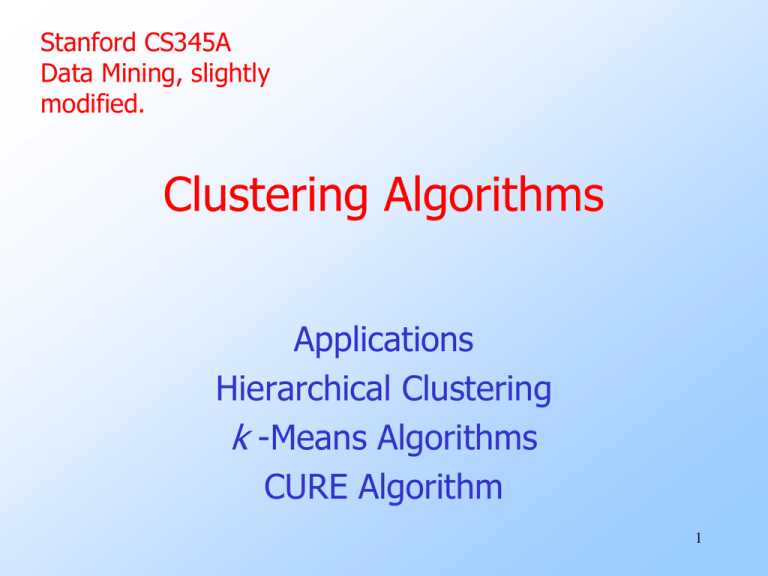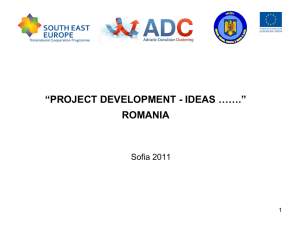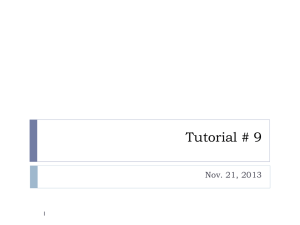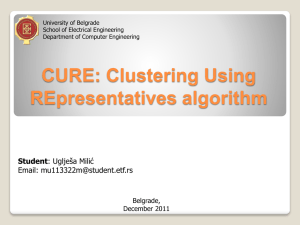Clustering
advertisement

Stanford CS345A
Data Mining, slightly
modified.
Clustering Algorithms
Applications
Hierarchical Clustering
k -Means Algorithms
CURE Algorithm
1
The Problem of Clustering
Given a set of points,
with a notion of distance between
points,
group the points into some number of
clusters, so that members of a cluster
are in some sense as close to each
other as possible.
2
Example
x
x
x
x x
x x
x xx x
x x x
x x
x
x
xx x
x x
x x x
x
xx x
x
x x
x x x x
x x x
x
3
Problems With Clustering
Clustering in two dimensions looks
easy.
Clustering small amounts of data looks
easy.
And in most cases, looks are not
deceiving.
4
The Curse of Dimensionality
Many applications involve not 2, but 10
or 10,000 dimensions.
High-dimensional spaces look different:
almost all pairs of points are at about
the same distance.
5
Example: Clustering CD’s
(Collaborative Filtering)
Intuitively: music divides into categories,
and customers prefer a few categories.
But what are categories really?
Represent a CD by the customers who
bought it.
Similar CD’s have similar sets of
customers, and vice-versa.
6
The Space of CD’s
Think of a space with one dimension
for each customer.
Values in a dimension may be 0 or 1 only.
A CD’s point in this space is
(x1, x2,…, xk), where xi = 1 iff the i
customer bought the CD.
th
Compare with boolean matrix: rows =
customers; cols. = CD’s.
7
Space of CD’s – (2)
For Amazon, the dimension count is
tens of millions.
An alternative: use minhashing/LSH to
get Jaccard similarity between “close”
CD’s.
1 minus Jaccard similarity can serve as
a (non-Euclidean) distance.
8
Example: Clustering Documents
Represent a document by a vector
(x1, x2,…, xk), where xi = 1 iff the i th
word (in some order) appears in the
document.
It actually doesn’t matter if k is infinite;
i.e., we don’t limit the set of words.
Documents with similar sets of words
may be about the same topic.
9
Aside: Cosine, Jaccard, and
Euclidean Distances
As with CD’s we have a choice when
we think of documents as sets of
words or shingles:
1. Sets as vectors: measure similarity by the
cosine distance.
2. Sets as sets: measure similarity by the
Jaccard distance.
3. Sets as points: measure similarity by
Euclidean distance.
10
Example: DNA Sequences
Objects are sequences of {C,A,T,G}.
Distance between sequences is edit
distance, the minimum number of
inserts and deletes needed to turn one
into the other.
Note there is a “distance,” but no
convenient space in which points “live.”
11
Methods of Clustering
Hierarchical (Agglomerative):
Initially, each point in cluster by itself.
Repeatedly combine the two “nearest”
clusters into one.
Point Assignment:
Maintain a set of clusters.
Place points into their “nearest” cluster.
12
Hierarchical Clustering
Two important questions:
1. How do you determine the “nearness” of
clusters?
2. How do you represent a cluster of more
than one point?
13
Hierarchical Clustering – (2)
Key problem: as you build clusters, how
do you represent the location of each
cluster, to tell which pair of clusters is
closest?
Euclidean case: each cluster has a
centroid = average of its points.
Measure intercluster distances by distances
of centroids.
14
Example
(5,3)
o
(1,2)
o
x (1.5,1.5)
x (1,1) o (2,1)
o (0,0)
x (4.7,1.3)
o (4,1)
x (4.5,0.5)
o
(5,0)
15
And in the Non-Euclidean Case?
The only “locations” we can talk about
are the points themselves.
I.e., there is no “average” of two points.
Approach 1: clustroid = point “closest”
to other points.
Treat clustroid as if it were centroid, when
computing intercluster distances.
16
“Closest” Point?
Possible meanings:
1. Smallest maximum distance to the other
points.
2. Smallest average distance to other
points.
3. Smallest sum of squares of distances to
other points.
4. Etc., etc.
17
Example
clustroid
1
2
6
3
4
5
clustroid
intercluster
distance
18
Other Approaches to Defining
“Nearness” of Clusters
Approach 2: intercluster distance =
minimum of the distances between any
two points, one from each cluster.
Approach 3: Pick a notion of “cohesion”
of clusters, e.g., maximum distance from
the clustroid.
Merge clusters whose union is most
cohesive.
19
Cohesion
Approach 1: Use the diameter of the
merged cluster = maximum distance
between points in the cluster.
Approach 2: Use the average distance
between points in the cluster.
20
Cohesion – (2)
Approach 3: Use a density-based
approach: take the diameter or
average distance, e.g., and divide by
the number of points in the cluster.
Perhaps raise the number of points to a
power first, e.g., square-root.
21
k – Means Algorithm(s)
Assumes Euclidean space.
Start by picking k, the number of
clusters.
Initialize clusters by picking one point
per cluster.
Example: pick one point at random, then
k -1 other points, each as far away as
possible from the previous points.
22
Populating Clusters
1. For each point, place it in the cluster whose
current centroid it is nearest to.
2. After all points are assigned, update the
locations of the centroids of the k clusters.
Or do the update as a point is assigned.
3. reassign all points to their closest centroid.
Sometimes moves points between clusters.
Repeat 2 and 3 until convergence
Convergence: Points don’t move between clusters
and centroids stabilize
23
Example: Assigning Clusters
Reassigned
points
2
4
x
6
7
5
x
3
1
8
Clusters after first round
24
Getting k Right
Try different k, looking at the change in
the average distance to centroid, as k
increases.
Average falls rapidly until right k, then
changes little.
Average
distance to
centroid
Best value
of k
k
25
Example: Picking k
Too few;
many long
distances
to centroid.
x
x
x
x x
x x
x xx x
x x x
x x
x
x
xx x
x x
x x x
x
xx x
x
x x
x x x x
x x x
x
26
Example: Picking k
Just right;
distances
rather short.
x
x
x
x x
x x
x xx x
x x x
x x
x
x
xx x
x x
x x x
x
xx x
x
x x
x x x x
x x x
x
27
Example: Picking k
Too many;
little improvement
in average
x
distance.
x x
x
x
x x
x xx x
x x x
x x
x
x
xx x
x x
x x x
x
xx x
x
x x
x x x x
x x x
x
28
BFR Algorithm
BFR (Bradley-Fayyad-Reina) is a variant
of k -means designed to handle very
large (disk-resident) data sets.
It assumes that clusters are normally
distributed around a centroid in a
Euclidean space.
Standard deviations in different dimensions
may vary.
29
BFR – (2)
Points are read one main-memory-full at
a time.
Most points from previous memory loads
are summarized by simple statistics.
To begin, from the initial load we select
the initial k centroids by some sensible
approach.
30
Initialization: k -Means
Possibilities include:
1. Take a small random sample and cluster
optimally.
2. Take a sample; pick a random point, and
then k – 1 more points, each as far from
the previously selected points as possible.
31
Three Classes of Points
1. The discard set : points close enough to
a centroid to be summarized.
2. The compression set : groups of points
that are close together but not close to
any centroid. They are summarized, but
not assigned to a cluster.
3. The retained set : isolated points.
32
Summarizing Sets of Points
For each cluster, the discard set is
summarized by:
1. The number of points, N.
2. The vector SUM, whose i th component is
the sum of the coordinates of the points in
the i th dimension.
3. The vector SUMSQ: i th component = sum
of squares of coordinates in i th dimension.
33
Comments
2d + 1 values represent any number of
points.
d = number of dimensions.
Averages in each dimension (centroid
coordinates) can be calculated easily as
SUMi /N.
SUMi = i
th
component of SUM.
34
Comments – (2)
Variance of a cluster’s discard set in
dimension i can be computed by:
(SUMSQi /N ) – (SUMi /N )2
And the standard deviation is the
square root of that.
The same statistics can represent any
compression set.
35
“Galaxies” Picture
Points in
the RS
Compressed sets.
Their points are in
the CS.
A cluster. Its points
are in the DS.
The centroid
36
Processing a “Memory-Load”
of Points
1. Find those points that are “sufficiently
close” to a cluster centroid; add those
points to that cluster and the DS.
2. Use any main-memory clustering
algorithm to cluster the remaining
points and the old RS.
Clusters go to the CS; outlying points to
the RS.
37
Processing – (2)
3. Adjust statistics of the clusters to
account for the new points.
Add N’s, SUM’s, SUMSQ’s.
4. Consider merging compressed sets in
the CS.
5. If this is the last round, merge all
compressed sets in the CS and all RS
points into their nearest cluster.
38
A Few Details . . .
How do we decide if a point is “close
enough” to a cluster that we will add
the point to that cluster?
How do we decide whether two
compressed sets deserve to be
combined into one?
39
How Close is Close Enough?
We need a way to decide whether to
put a new point into a cluster.
BFR suggest two ways:
1. The Mahalanobis distance is less than a
threshold.
2. Low likelihood of the currently nearest
centroid changing.
40
Mahalanobis Distance (M.D.)
Normalized Euclidean distance from centroid.
For point (x1,…,xk) and centroid (c1,…,ck):
1. Normalize in each dimension: yi = (xi -ci)/i
2. Take sum of the squares of the yi ’s.
3. Take the square root.
41
Mahalanobis Distance – (2)
If clusters are normally distributed in d
dimensions, then after transformation,
one standard deviation = d.
I.e., 68% of the points of the cluster will
have a Mahalanobis distance < d.
Accept a point for a cluster if its M.D. is
< some threshold, e.g. 4 standard
deviations.
42
Should Two CS Subclusters Be
Combined?
Compute the variance of the combined
subcluster.
N, SUM, and SUMSQ allow us to make that
calculation quickly.
Combine if the variance is below some
threshold.
Many alternatives: treat dimensions
differently, consider density.
43
The CURE Algorithm
Problem with BFR/k -means:
Assumes clusters are normally distributed
in each dimension.
And axes are fixed – ellipses at an angle
are not OK.
CURE:
Assumes a Euclidean distance.
Allows clusters to assume any shape.
44
Example: Stanford Faculty Salaries
h
e
e
salary
h h h
e h
e
e
e
h
e
h
h
e
e
h
e
e
h
h
h
h
age
45
Starting CURE
1. Pick a random sample of points that fit
in main memory.
2. Cluster these points hierarchically –
group nearest points/clusters.
3. For each cluster, pick a sample of
points, as dispersed as possible.
4. From the sample, pick representatives
by moving them (say) 20% toward
the centroid of the cluster.
46
Example: Initial Clusters
h
e
e
salary
h h h
e h
e
e
e
h
e
h
h
e
e
h
e
e
h
h
h
h
age
47
Example: Pick Dispersed Points
h
e
e
salary
h h h
e h
h
e
h
h
e
e
h
h
e
e
h
h
h
e
e
e
Pick (say) 4
remote points
for each
cluster.
age
48
Example: Pick Dispersed Points
h
e
e
salary
h h h
e h
h
e
h
h
e
e
h
h
e
e
h
h
h
e
e
e
Move points
(say) 20%
toward the
centroid.
age
49
Finishing CURE
Now, visit each point p in the data set.
Place it in the “closest cluster.”
Normal definition of “closest”: that cluster
with the closest (to p ) among all the
sample points of all the clusters.
50








